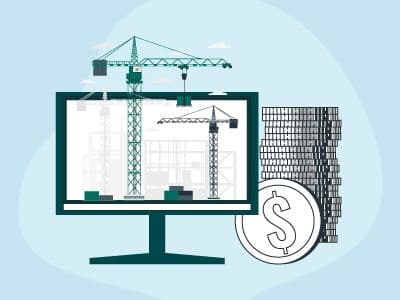Are you looking for software for construction management but not sure how much you should pay? Unfortunately, there is no answer. Even free or open-source construction software may contain hidden costs that throw your original budget into disarray.
Keeping this in mind, we've compiled this comprehensive guide to assist you in comparing the pricing of top-rated construction solutions.
Construction Software Pricing
The cost of construction software is determined by the type of products required and the amount of construction done. Therefore, the more projects you run via the platform, the more value you get from the program regarding cost reductions, efficiency, and productivity increases.
Construction management systems typically use a subscription-based pricing model that does not necessitate the purchase of a license. Instead, consumers pay the software vendor on a monthly or annual basis.
Construction management software costs as little as $44 per contractor per month and can cost as much as $2,850 per contractor per month. Businesses can expect to pay between $299 to $9,900 per month for additional contractors and advanced functionality.
Based on the number of contractors, we may categorize the various pricing plans as basic, premium, and advanced. As the basic plan only covers a few fundamental elements of the software, the price for these three pricing ranges increases from low to high. In contrast, premium plans cover advanced features in addition to basic features. Furthermore, the advanced plan is the most expensive of the three due to more advanced capabilities that enable large teams or organizations.
Construction Software - Upfront and Recurring Costs
You pay a one-time charge to own and utilize the construction software forever.
Upfront Costs
- One-time license charges.
- Computer hardware (e.g., servers)
Recurring Costs
- Maintenance
- Premium support services (e.g., expanded phone support hours)
Hidden Costs
- Integration
- Customization
- Staff overtime.
Subscription License
You pay a monthly subscription to utilize the construction software for a set time period.
Upfront Costs
- Setup
Recurring Costs
- Monthly subscription charges
- Premium support services
Hidden Costs
- Integration
- Customization
Free and Open-Source License
There are no fees to use the construction program, and you are free to use, edit, and share it.
Upfront Costs
- Setup
Recurring Costs
- None
Hidden Costs
- Integration
- Customization
Additional Expenses
Once you're familiar with the various price structures, consider additional fees when deploying new construction software. These extra costs are universal, independent of your selected vendor's pricing scheme; therefore, make sure you budget for the following:
Data Migration
This process exports your clients' data from your old software as files that you can import into the new system. Buyers are frequently surprised by this cost.
Read More: How to Pick Project Management Tool for Your Business?
Training
Depending on how extensive the staff training for the new system is, it can range from free to several thousand dollars. Vendors now offer various free online training materials, such as webinars and how-to videos, that can assist reducing those extra costs. However, it may be essential to hire an installation specialist to get your personnel up to speed as soon as possible to avoid costly downtime. This is usually more expensive.
Maintenance and Upgrades
It is critical to understand the vendor's maintenance and support services and whether they are included in your software subscription or licensing fees. On the other side, you may already have maintenance and support personnel on your team. It's critical to understand what support your software vendor provides if your team is unable to provide maintenance for the tool, which could directly impact the ROI that your product was designed to produce.
Hardware
Is it necessary to make any new purchases or change your existing infrastructure to implement the software? For example, individual employee gear, such as computers or mobile devices, may need an upgrade regularly.
Bottom Line
Before you begin considering vendors for construction software models, it's critical to consider the above-mentioned often-overlooked expenditures. In this manner, you may include them in your budget from the beginning.
